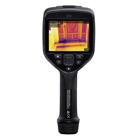New features for Flir thermal imaging cameras

Flir Systems’ latest additions to Exx-Series of advanced thermal-imaging camera are designed for electrical, mechanical and building applications. There are three models (E75, E85 and E95), all of which are Wi-Fi-enabled and feature intelligent interchangeable lenses, laser-assisted autofocus modes and area-measurement functionality, improvements to the company’s patented MSX imaging technology and a larger 4 in touchscreen.
Taken together, the new features, together with increased sensitivity and increased native resolution, will help identify hot spots or building deficiencies before potential problems become expensive repairs.
The interchangeable lenses are automatically recognised by the camera and calibrated, so there is no need for manual calibration.
Laser distance measurement ensures precise autofocus to improve temperature-measurement accuracy.
In conjunction with Flir Tools, these new cameras are the first to offer the Ultramax embedded super-resolution process to improve effective resolution by four times (up to 645 888 pixels) and thermal sensitivity by up to 50%.
The user interface has been simplified, and cameras can be connected by Wi-Fi, Bluetooth and Meterlink for archiving data and generating reports.







